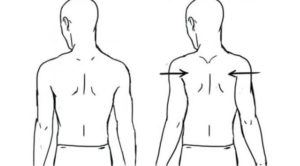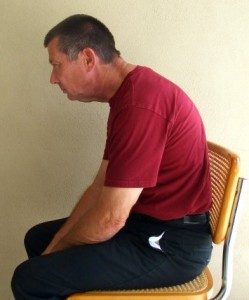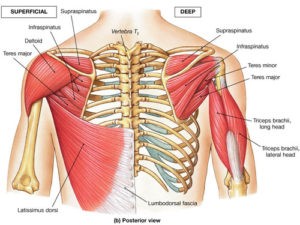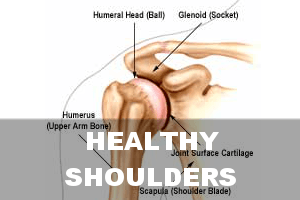Today we are introducing you to the concept of scapular retraction..

Scapular retraction is a backward movement toward the midline of the body; moving the scapula back toward the spine during retraction of the shoulder girdle. [4] Scapular retraction requires the activation of the trapezius, rhomboideus major and minor muscle groups. Postural imbalances, specifically those in which the upper back is rounded and slouched, are often the result of weakness in these muscle groups.

This is even more so with individuals who have tight anterior musculature which influence posture – pectoralis major and minor being the 2 most important.By loosening the anterior musculature through stretching and utilizing exercises that involve scapular retraction, individuals may be more successful at improving their postural issues.
Here are some exercises which involve scapular retraction that are beneficial for maintaining healthy posture: [2]
Resistance Band Row
Initiate your shoulder retractor muscle strengthening with a resistance band. Sitting upright on the floor, wrap a resistance band around both of your feet, keeping your feet and legs together. Monitor your alignment in a mirrored wall to make sure your back is straight throughout the exercise. Grasp the handles of the resistance band, rolling up further on the band if your legs are shorter or you are not feeling resistance. Without moving your trunk, pull your arms toward your chest, allowing your elbows to flare out sideways at chest height and then return your arms to the starting position.
Cable Rowing
Sit as the rowing station of your weighted cable exercise machine. Position your body several feet away from the foot plate so that your knees are slightly bent between 15 and 20 degrees. Straighten your back and tighten your abdominal muscles to protect your lower back. Lean forward at your pelvis and grab hold of the bar attached to the pulley system. Place your pelvis back into the starting position and do not move your pelvis or trunk while performing the row. Pull your arms back so your hands come toward the side of your chest and then return your arms almost to the fully straightened position, taking care not to lock out your elbows or allow your shoulders to roll forward.
Transverse Cable Row
Exercise the upper and lower muscle fibers of your retractors to achieve muscle symmetry. Using a rope attachment placed on the highest setting of a pulley system, lean back slightly while keeping your body straight and your hands on the rope attachment. Without moving your legs or trunk, pull the rope toward your eyes, branching your arms out at you reach your face and then return to the starting position. Using the same setup, except placing the pulley at the lowest setting near the floor, without leaning forward, pull upward on the pulley, pushing your elbows straight up toward the ceiling and return to the starting position.
Advanced Row
Perform an advanced row while standing to work your back, abdominals, legs and stabilizing muscles simultaneously. Using either a resistance band wrapped around a pole or a pulley system set around mid-thigh height, squat into a full squat while holding the handles. Walk backward in the squat just to the point of resistance. Keeping your legs and trunk stable throughout, pull your arms back and squeeze your shoulder blades together. Return to the starting position without lunging forward.
If you are suffering from shoulder discomfort and postural imbalances are not the cause of your pain, the weakened musculature of the rotator cuff may be the culprit. The muscles of the rotator cuff include the supraspinatus, infraspinatus, teres minor, and subscapularis. Together, these muscles are known as the “glenohumeral guardians”. [1]

One of the best ways to protect the shoulder from injury during sport is to be proactive with your exercise regiment by using specific exercises that target the musculature surrounding the scapula and glenohumeral joint.
Here are some exercises to help strengthen the rotator cuff muscles: [3]
Empty Can Exercise
Stand square with a small dumbbell in your right hand. Orient your right arm at a 45-degree angle to your body and turn your right hand thumb-down. It might help to imagine that you’re emptying a can of soda just beside your right foot. Lift your straight arm up and out, maintaining the 45-degree angle to your body. Stop when your arm is almost level with your shoulder. Complete a full set, then repeat on the other side.
This exercise works your supraspinatus, which is primarily responsible for abducting your shoulder and stabilizing the shoulder blade. This muscle is the most commonly injured muscle in the rotator cuff. If the exercise causes pain, stop immediately; the pain may signal a rotator cuff injury.
External Rotation
Lie on your right side with a small dumbbell in your left hand. Bend your left arm at a right angle, tucking the elbow close against your side. Let your left forearm swing down against your body, then swing it back up to the starting position. Complete a full set, then repeat on the other side.
This works the infraspinatus. The infraspinatus externally rotates, transversely abducts and transversely extends your arm at the shoulder. According to ExRX, this is the second most frequently injured rotator cuff muscle.
Stop Sign Exercise
Stand square with a dumbbell in your right arm. Position your right arm as if you were going to do a shoulder press, elbow bent at 90 degrees, palm facing forward, weight directly above your elbow. Rotate your upper arm only, swinging your hand down to the “stop” hand signal. Allow discomfort to limit your range of motion; only rotate your arm as far as comfortably possible. Complete a full set, then repeat on the other side.
This exercise works the teres minor. Like the infraspinatus, the teres minor externally rotates, transversely abducts and transversely extends your arm at the shoulder.
Internal Rotation
Lie on your right side on a bench or table, gripping a small dumbbell in your right hand. Tuck your right elbow against your side just in front of your body, forearm sticking straight out in front of you. Rotate your upper arm so that your forearm swings up against your ribs. Lower your arm back to the starting position. Complete a full set, then repeat on the other side.
This works your subscapularis, which as the name indicates is located deep to your shoulder blades. The subscapularis internally rotates your arm at the shoulder.
References:
[1] Paine, R., & Voight, M. L. (2013). THE ROLE OF THE SCAPULA. International Journal of Sports Physical Therapy, 8(5), 617–629.
[2] http://www.livestrong.com/article/536301-scapular-retraction-exercises-for-posture/
[3] http://www.livestrong.com/article/233274-shoulder-exercises-to-strengthen-rotator-cuff/
[4] http://www.exrx.net/Articulations/Scapula.html

